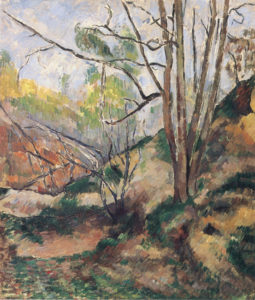R376 Sous-bois vers 1879 (FWN132)
Pavel Machotka
(Cliquer sur l’image pour l’agrandir)
Sous-bois is a fascinating example of Cézanne’s most resolute use of the parallel touch: he uses it here to represent a site that seems not to have invited it naturally, so scattered it must have appeared (unlike Le Pont de Maincy, R436 FWN143). The touch does of course describe the slope of the right hillside intuitively, following its slope and then leveling out at the bottom, but in the background and in the sky it is independent of whatever it stands for. Representing the site is for Cézanne a secondary matter; creating a picture with a rhythmical internal order is primary. He reveals the purpose clearly in the way he uses the cluster of bare branches to balance the heavy hillside, which they do by pointing in exactly the opposite direction. But they do not do this alone. It is the parallel touch that given them their force: it is assembled in long, stringy groups that just touch them, filling the spaces between them with a seemingly firm substance. The composition becomes integrated, and if the work in integrating the picture seems great, one cannot imagine any other touch achieving it .
Adapted from Pavel Machotka, Cézanne: The Eye and the Mind.


